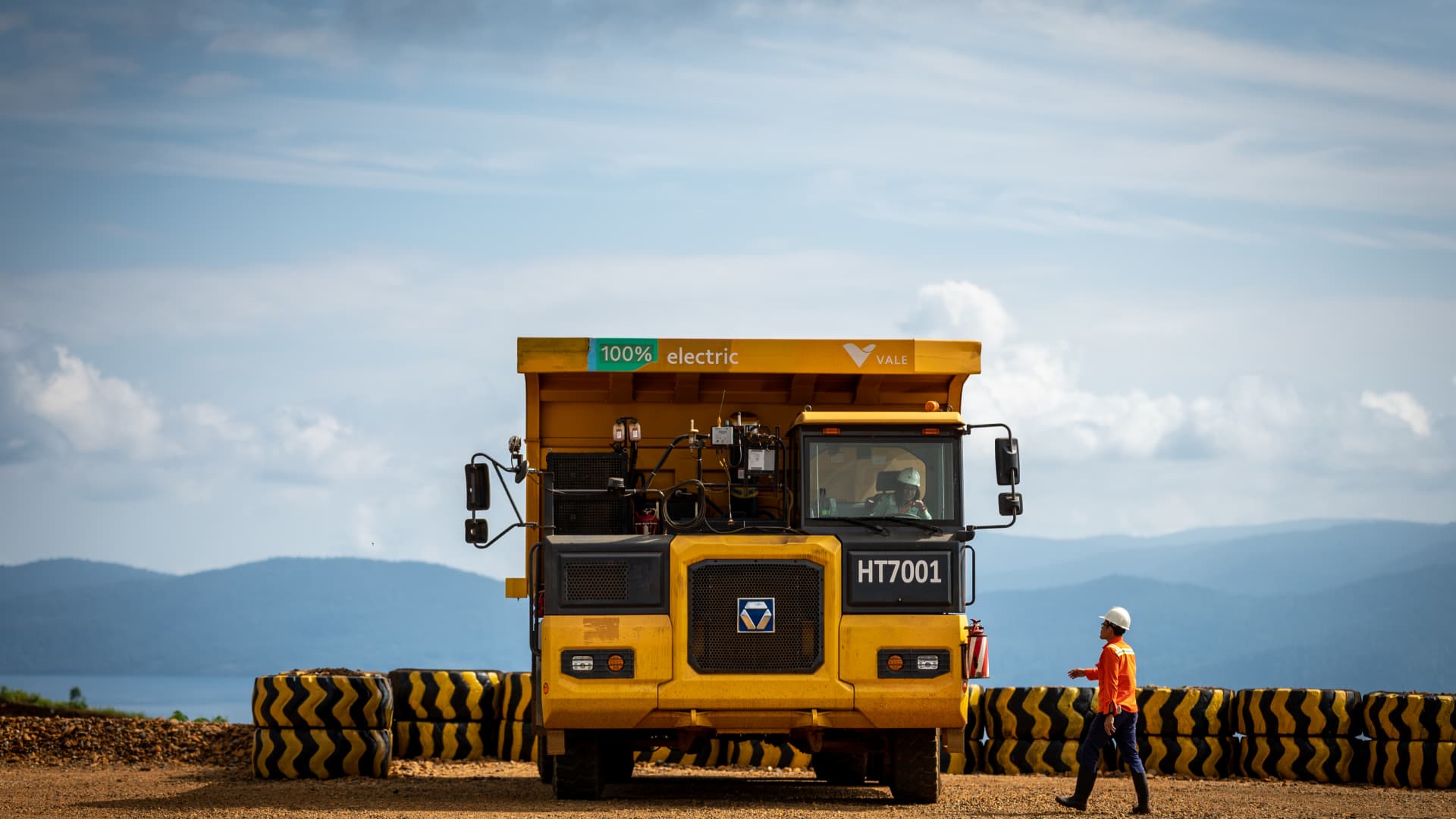An electric truck at the PT Vale Indonesia mining area. The CXMG type XDR-80-TE truck manufactured in China boasts a hauling capacity of 70 tons.
Sopa Images | Lightrocket | Getty Images
The next time micromobility company Lime accepts a shipment of e-bikes and e-scooters in California, a new state law means the cargo must be loaded onto an electric truck.
Drayage trucks, which bring cargo from ports to warehouses nearby, must make the move to electric by 2035 in the U.S. state.
Lime, the company behind e-bike and e-scooter rentals across North America, recently inked a deal for truck provision with California-based logistics firm Hight Logistics, which focuses on zero-emissions transport.
Andrew Savage, VP for sustainability at Lime, told CNBC that the company has its own goals for reaching zero emissions, but that there needs to cooperation across the entire supply chain.
“As we’ve looked at achieving those goals, it is completely clear that we are going to need to rely on the industries around the business that help facilitate our business to get there,” Savage said. “We’re going to need to see the decarbonization of things like freight, of sea shipping, of manufacturing to be able to meet the ambition that we have to decarbonize our business.”
One starting point on that journey is using electric trucks to move Lime’s shipments from the ports of Los Angeles and Long Beach to the company’s distribution center in California, before they are ultimately trekked across the U.S. and Canada.
The collaboration between Lime and Hight is small in the grand scheme of things, as the transition to electric trucks continues gradually, with long-distance journeys still largely carried out by diesel-powered trucks.
“That’s the next critical step, and what we’re expecting and relying on is that the freight industry continues to expand in both the technology of the vehicles and the infrastructure to charge those vehicles,” Savage said.
“We expect that to happen quickly and the one thing we do know is that it has to be done through demand from cargo owners like Lime, so that the innovation and investment gets there.”
Transitioning fleets to electric
Across the Atlantic, Dutch brewer Heineken recently partnered with Swedish electric truck start-up Einride to make the transition to electric.
A fleet of five electric trucks will initially transport shipments of Heineken’s beer from its brewery in the Netherlands to a distribution center in Germany.
Heineken’s global strategic supply chain director Arjen van der Woude told CNBC that this is not just a case of putting an electric truck on the road to simply replace traditional vehicles.
Freight owners like Heineken need to have rich volumes of journey data, as well as a bird’s eye view of charging infrastructure along these routes, to make the investment in electric worthwhile.
“I can buy an electric truck today for twice the price of diesel, but that that’s not the solution,” van der Woude said. “The solution is to integrate it in your network and make sure that the combination of waiting times, charging time, driver limitations on the hours he or she can drive is all managed seamlessly, and that is where [Einride’s] platform, the digital platform, kicks in.”
Einride is working with several major consumer brands that are making the move to electric, including supermarket chain Lidl and Sweden’s Oatly, which provides oat-based alternatives to dairy products.
For Einride CEO Robert Falck, the challenges for electric truck uptake are slightly different than those of cars. A regular concern among consumers buying electric cars is range and the access to charging points.
“People always talk about range. But the range is actually a very inaccurate way of describing the efficiency of the system. What the challenge is with electric is to see that you have the operational uptime to make it competitive versus diesel. That’s the challenge,” Falck said.
“There is a way you can work with that, and you need to be way more systematic when you do, how you run and operate, how you plan, how you adapt to the weight of the cargo, and so on.”
Getting more electric trucks to carry cargo on the road, especially for long-distance journeys, will need to be spearheaded by cargo owners that want their goods moved sustainably.
In March, Danish shipping and logistics giant DFDS announced that it would order 100 new electric trucks from Volvo between this year and next, to meet growing customer demands for more sustainable transport.
Many of the new trucks will be deployed in markets where DFDS has not yet moved to electric trucks, including in the U.K.
In a statement, the firm said that demand for electric transport has been the highest in Nordic countries, but is “steadily rising in the rest of Europe as well.”
Lime’s Savage said that the regulation will be a major driving force for this transition.
In California, Lime’s use of electric trucks has been driven by legislation that states all drayage trucks must be zero-emissions by 2035.
Savage said that Lime wants to repeat what it has done in California in Europe, even in the absence of new laws. In Europe, Lime brings its cargo into the port of Rotterdam and is currently seeking out similar partnerships there to electrify offloading its shipments, according to Savage.
“As we look at other distribution points, we will be demanding and looking for similar ways of decarbonizing our freight,” he said.
Autonomous driving
Many in the trucking and logistics industry believe that electric trucks will ultimately be fully autonomous, transporting goods up and down highways without anyone behind the wheel.
Einride’s Falk said that autonomous driving has “passed the hype” and the company has built a truck that fully meets this criterion and is in commercial use.
Such a truck has been deployed by manufacturer GE Appliances at its plant in Tennessee, from where it carries goods on a journey of less than a mile to a warehouse.
It is a relatively small use case for AI-powered autonomous electrics trucks, it will be a vital step in further developing a broader automated workflow, according to GE Appliances.
“We’re scaling up a lot of cases over the next years,” Falck said, adding that he expects the next five to 10 years to be busy, with more commercial deployments of autonomous trucks across the industry.
“At the end of this decade, I wouldn’t say that autonomous will become a massive deployment and replace everything else but it will be a very common sight in a lot of applications. I think that it will happen faster on scale for freight because the business case there it’s just much better.”







